Across the Rajang River
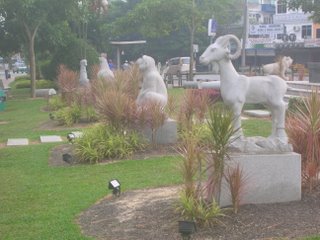
Some wonderful travel books about Borneo have helped make it into an exotic destination. Redmond O’Hanlon headed Into the Heart of Borneo while Eric Hansen was the Stranger in the Forest. Michael Crichton’s Travels, includes Borneo in his tales of out-of-the-way places. The mighty Rajang river is the usual route taken, guides are procured and life-threatening adventures ensue. Quantities of tuak, a local homebrew, are consumed in long houses along route and wild parties continue through the night. Hospitality upriver is legendary but not always what gets classified as family entertainment. But the tourist industry is nothing if not remarkably adaptive and when I was in the local tourist office purchasing tickets for the Rainforest World Music Festival there were several families booking trips up the Rajang River.
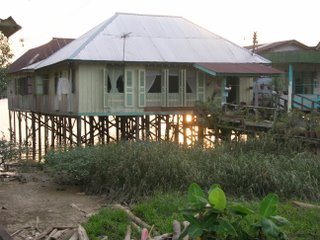 I have been rereading the books so I know that real adventures in these parts set off from the Sibu wharf in Kuching, head down the Sarawak river to the South China Sea and then turn east for 5 or 6 hours until they reach the mouth of the Rajang river. The Rajang is a busy water channel in a way that most of our rivers are no longer. It has ocean going ships as well as tugs, fishing boats, Chinese river launches and log filled barges.
I have been rereading the books so I know that real adventures in these parts set off from the Sibu wharf in Kuching, head down the Sarawak river to the South China Sea and then turn east for 5 or 6 hours until they reach the mouth of the Rajang river. The Rajang is a busy water channel in a way that most of our rivers are no longer. It has ocean going ships as well as tugs, fishing boats, Chinese river launches and log filled barges. Sibu is the premier port on the Rajang, and lies a couple of hours in from the mouth. One of the early Chinese trading centers and settlements, it is a modern bustling port. Locals refer to it as a cowboy town by which they mean, I think, that there is a certain kind of Wild West lawlessness that is common to harbours around the world. It has the best selection of DVDs I have seen, most of them from China, as well as a lovely waterside park and a bustling harbour.
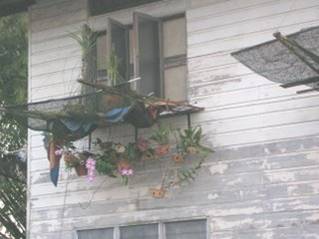
I am flying in for an overnight visit. The harbour and river remain the hub of Sibu. Malay houses perch serenely on tall stilts over the banks, their curtains flapping in the breeze. Water taxis ply their trade along the river edge. Hanging orchid gardens are suspended from windows, sheltered from excessive sun by black net.
In the 4th year of the five year medical course, students do three months of field work. As a group they meet and discuss health concerns with a rural community to arrive at a topic of study. The communities are very keen to have the students so efforts are made to go to different areas. The WHO directive of “No survey without service“ is taken seriously and towards the end of the community stay not only do students report to the community on their findings but some intervention, usually health education, is undertaken. The students will be staying in a village outside Sarekei, which is further inland across a couple of rivers.
There are approximately 80 students in each class with 10-20 per group. Staff from the school stay with the students in the field, so the movement and organization of such placements are massive undertakings. In this area, medical education in the developing world is ahead of the rest of the world in connecting with the community in a meaningful way.
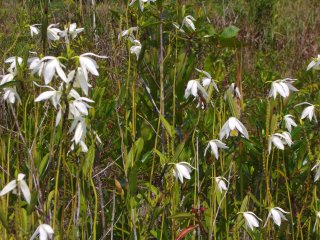 A brand new bridge takes us across the Rajang. I miss the forty minute ferry that used to be required with vendors at both ends who sold guava slices coated in spices, ice cream and hot snacks. There is a rhythm about working ferries that adds to a river. The loading and unloading of trucks, motorbikes and vehicles, the sweep of ferries past each other midstream and the swing of their extended front lip over the concrete loading platform on each side.
A brand new bridge takes us across the Rajang. I miss the forty minute ferry that used to be required with vendors at both ends who sold guava slices coated in spices, ice cream and hot snacks. There is a rhythm about working ferries that adds to a river. The loading and unloading of trucks, motorbikes and vehicles, the sweep of ferries past each other midstream and the swing of their extended front lip over the concrete loading platform on each side.We drive for an hour, the roadsides edged with wild bamboo orchids, to reach Sarikei, where two small ferries maneuver back and forth in a slow dance to deliver us right into the heart of Sarikei.
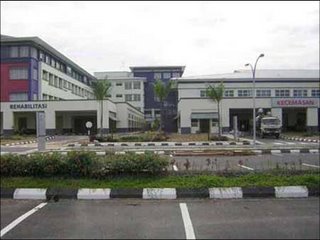
We meet up with the students in the divisional headquarters after they have visited the village. They have prepared a knowledge, attitudes and practices (KAP) survey on hypertension. Our students speak Bahasa Malay, but they have found that they don’t understand the dialect in this village all that well. Field work provides an invigorating dose of reality and is an eye-opener on many levels.
The acting in charge, a medical assistant, gives us an overview of the health in his region. A map showing the health units is prominently displayed on the wall. The area covered is extensive, settlements are small and scattered and the whole area crisscrossed by rivers but few roads. The single, new hospital in Sarikei serves a huge hinterland.
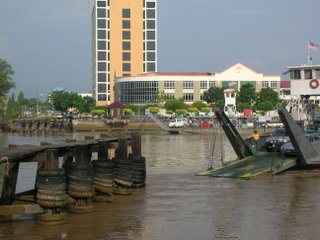
I caution my students when looking at the facts to be alert to the "factoids". "Factoids", by my definition, are facts with a charge, usually an emotional one. The "factoid" that jumps out at me from all the statistics presented about this division is that although 24 posts have been assigned for physicians, only 4 have been filled and none of the physicians are on site.
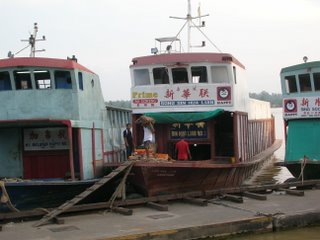
The concentration of physicians in urban areas is a serious problem everywhere but it serves as another reminder of why we are here and why this program is so crucial. As we leave, the district nurse reminds the students that they are going to need their bednets and a plan to ensure a safe water supply. It is one thing to know something, it is quite another to actually have to deal with it yourself.
Back in Sibu, river taxis move people and things from one site to another. Long boats are clustered at various spots along the bank. What Sibu doesn’t seem to have is many container boats. Boats on the Rajang appear to be loaded and unloaded by heavily laden men moving steadily up and down the sloping planks between the deck and the dock. We watch a Chinese craft unload huge creamy slabs, the men tramping up the gangplank to heave them in the back of a waiting truck. I take pictures not really knowing what I am looking at. Later my colleagues tell me the slabs are latex which has been treated with formic acid to produce large sheets which are then folded over on themselves.
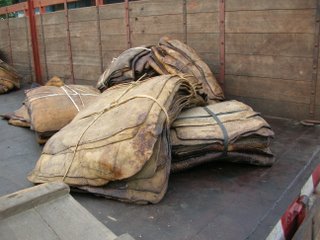
The price of rubber on the world market has recently gone up, a situation that has generated much interest here and talk of new plantations. I’m not sure what is driving this demand but one is aware here of how dependent on primary extraction industries, developing countries are. Indeed they seem to be the only ones still producing basics such as sugar, cotton, coffee, rubber, jute, etc. So I can’t help hoping that we continue to require such products.
While the push right now in Malaysia is to produce more doctors, I think as I head home that if Western experience is any guide, such measures are not anywhere near the whole answer. What we probably should be focusing on now is how to best support, equip and prepare those health workers who stay in rural areas to better do their work, both here and in North America.
Photos: Sibu Chinese park, Malay home onstilts, suspended orchid garden, ferry in Sarekei, bamboo orchids by roadside, new Sarekei hospital, offloading latex slabs, and latex slabs in back of truck
Labels: Sarawak


4 Comments:
I like this post about Sarikei. Sarikei hospital has come a long way from the old days. I intend to blog about the evolution soon.
Check out my Sarikei website
http://sarikei-time-capsule.blogspot.com/
thank you for posting good insightful articles on Sarawak in general and Sibu in particular.
Welcome to my site, Sarawakiana. Glad to have someone look at these posts from several years ago.
--traveling doc
one in a million.... The latex boat in your article is a cargo boat plying between Kapit (upstream Sibu) and Sibu. I was searching the internet for pictures of wild orchids in Borneo. I found some and I also found the picture of a cargo boat that I owned
many years back!
Post a Comment
<< Home